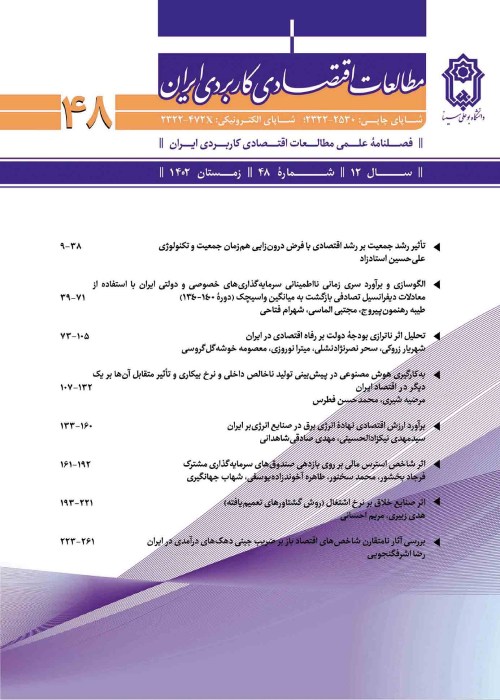Implementation of value added tax on bank sector in explaining Iran economic fluctuations using the approach of New Keynesian dynamic stochastic general equilibrium
Author(s):
Article Type:
Research/Original Article (دارای رتبه معتبر)
Abstract:
Goal: The value added tax is now being implemented in more than 140 countries. This tax is a tax on the sale of goods and services, which are applied in the chain of import, production, distribution, consumption at a constant (non-progressive) tax rate, and ultimately final consumers are the only payable one. Banking services are exempt from value added tax for technical reasons in most countries of the world.
In this case, everything that the bank purchases from other firms to provide services is subject to value added tax, but cannot claim tax on it. Since the interest rates in Iran are determined by an order and externally and banks cannot transfer their taxes to these rates, the costs of the bank have increased and, therefore, their liquidity has decreased and the loans are reduced. In recession and reducing firm's access to domestic resources, they have to be financed externally, which would increase the cost of firms, as well as the problems caused by shortages of banking resources, these costs increase and ultimately leads to escalation of stagnation. A liquidity shock reduces the ability of firms to finance investment projects. This decrease the value of the assets of the firm would increase the cost of external financing and lead to an increase in the cost of new investments. By reducing investment in economic activity and cash flow in future projects, the effects of the initial shock are repeated.
Methodology
Value-added tax not subject to tax is the difference between the interest rate on borrowings from the bank and the interest rate that the bank pays to depositors. Financial institutions also earn revenues from providing some services, such as paying services, which are exempt from taxes.In this case, everything that the bank purchases from other firms to provide services is subject to value added tax, but cannot claim tax on it. Since the interest rates in Iran are determined by an order and externally and banks cannot transfer their taxes to these rates, the costs of the bank have increased and, therefore, their liquidity has decreased and the loans are reduced. In recession and reducing firm's access to domestic resources, they have to be financed externally, which would increase the cost of firms, as well as the problems caused by shortages of banking resources, these costs increase and ultimately leads to escalation of stagnation. A liquidity shock reduces the ability of firms to finance investment projects. This decrease the value of the assets of the firm would increase the cost of external financing and lead to an increase in the cost of new investments. By reducing investment in economic activity and cash flow in future projects, the effects of the initial shock are repeated.
Results
The value added tax has many features that have made it one of the attractive ways for governments to increase revenue. This tax is levied on all sales, including wholesale and retail, and allows firms to pay taxes on their purchases at each stage. So that tax is transferred to the next stage and ultimately the final consumer will be the taxpayer. In practice, most goods and services are not subject to the standard rates of value added tax, and some of them are subject to tax exemptions. One of the cases that has been exempted in most countries of the world is banking services. In this case, the banks do not charge value-added tax on the sale of their services, but likewise do not receive input credits for VAT paid on their inputs. Exemption creates a number of distortions in economy. This study in order to understand the importance of VAT in macroeconomic fluctuations and fundamental role of financial intermediaries shocks on the economy investigates the effects of VAT levied on banks using a standard dynamic stochastic general equilibrium model for the Iran economy. Banks have a central role in model and different interest rates for deposits and loans are considered. Vat is levied on the difference between the two rates. The imposition of VAT on the difference these rates, resulting in sudden changes in other macroeconomic variables has been investigated. By determining the input values and model parameters using the calibration procedure during the period 1370-1394 the results of the simulation variables of the model indicates a model describing the dynamics of the Iran economy.Conclusion
In addition, the response functions due to the increased rate of VAT on banking and monetary and productivity shocks has been investigated. The results suggest that imposing VAT on banks reduces their costs and increases bank reserves and their lending power so the supply of credit, investment and production increases. Improved technology also appears to increase the productivity of manufacturing firms and increases the demand for bank loans and on the other hand increases the loan supply. As a result of this process, investment and consumption will be increased. Keywords:
Language:
Persian
Published:
Quarterly Journal of Applied Economics Studiesin Iran, Volume:7 Issue: 25, 2018
Pages:
85 to 110
magiran.com/p1819973
دانلود و مطالعه متن این مقاله با یکی از روشهای زیر امکان پذیر است:
اشتراک شخصی
با عضویت و پرداخت آنلاین حق اشتراک یکساله به مبلغ 1,390,000ريال میتوانید 70 عنوان مطلب دانلود کنید!
اشتراک سازمانی
به کتابخانه دانشگاه یا محل کار خود پیشنهاد کنید تا اشتراک سازمانی این پایگاه را برای دسترسی نامحدود همه کاربران به متن مطالب تهیه نمایند!
توجه!
- حق عضویت دریافتی صرف حمایت از نشریات عضو و نگهداری، تکمیل و توسعه مگیران میشود.
- پرداخت حق اشتراک و دانلود مقالات اجازه بازنشر آن در سایر رسانههای چاپی و دیجیتال را به کاربر نمیدهد.
In order to view content subscription is required
Personal subscription
Subscribe magiran.com for 70 € euros via PayPal and download 70 articles during a year.
Organization subscription
Please contact us to subscribe your university or library for unlimited access!


